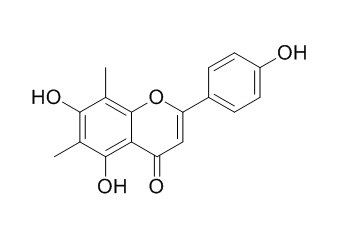Syzalterin
Syzalterin can protect PC12 cells effectively against Abeta-induced toxicity.
Inquire / Order:
manager@chemfaces.com
Technical Inquiries:
service@chemfaces.com
Tel:
+86-27-84237783
Fax:
+86-27-84254680
Address:
1 Building, No. 83, CheCheng Rd., Wuhan Economic and Technological Development Zone, Wuhan, Hubei 430056, PRC
Providing storage is as stated on the product vial and the vial is kept tightly sealed, the product can be stored for up to
24 months(2-8C).
Wherever possible, you should prepare and use solutions on the same day. However, if you need to make up stock solutions in advance, we recommend that you store the solution as aliquots in tightly sealed vials at -20C. Generally, these will be useable for up to two weeks. Before use, and prior to opening the vial we recommend that you allow your product to equilibrate to room temperature for at least 1 hour.
Need more advice on solubility, usage and handling? Please email to: service@chemfaces.com
The packaging of the product may have turned upside down during transportation, resulting in the natural compounds adhering to the neck or cap of the vial. take the vial out of its packaging and gently shake to let the compounds fall to the bottom of the vial. for liquid products, centrifuge at 200-500 RPM to gather the liquid at the bottom of the vial. try to avoid loss or contamination during handling.
Eur J Pharm Sci.2016, 94:33-45
Natural Product Communications2020, doi: 10.1177.
EXCLI J.2023, 22:482-498.
Journal of Mushroom2024, 22(4):192-198
British Jou. Med.&Med. Research2014, 1802-1811
Malaysian Journal of Analytical Sciences2023, 27(4):840-848.
Food Control2022, 132:108434.
Molecules.2023, 28(8):3414.
J Traditional Thai Medical Res.2022, 8(1):pp1-14.
Int Immunopharmacol.2021, 101(Pt A):108181.
Related and Featured Products
Planta Med. 2010 Jun;76(9):863-8.
C-methylflavonoids isolated from Callistemon lanceolatus protect PC12 cells against Abeta-induced toxicity.[Pubmed:
20101562]
Increased beta-amyloid (Abeta) production and its aggregation to the oligomeric state is considered to be a major cause of Alzheimer's disease (AD). Therefore, reducing Abeta-induced neurotoxicity could provide a suitable means of prevention or intervention in the disease course of AD. The neuroprotective effects of isolates from Callistemon lanceolatus DC. (Myrtaceae) against Abeta were evaluated using PC12 cells.
METHODS AND RESULTS:
To evaluate the effects of Abeta on apoptotic cell death and the effects of Bcl-2 family proteins and caspase-3, TUNEL assays and Western blotting were performed, respectively. Substantial fractionation and purification of the EtOAc-soluble extract of the aerial parts of C. lanceolatus afforded six flavonoids, 4',5-dihydroxy-6,8-dimethyl-7-methoxyflavanone (1), eucalyptin (2), 8-demethyleucalyptin (3), sideroxylin (4), Syzalterin (5), and quercetin (6). Compounds 1, 5, and 6 were found to protect PC12 cells effectively against Abeta-induced toxicity. In particular, compound 1 showed the most promising neuroprotective effect with an ED (50) value of 6.7 microM in terms of decreasing Abeta-induced apoptotic cell death, and this was accompanied by a decrease in caspase-3 activation and an increase in Bcl-2/Bax ratio.
CONCLUSIONS:
These results suggest that compound 1 could be developed as a candidate anti-AD agent due to its attenuation of Abeta-induced apoptotic cell death.
Chin J Nat Med. 2015 Aug;13(8):628-33.
Identification and characterization of three new flavonoids from Rhododendron dauricum.[Pubmed:
26253496]
The present study was designed to determine the major chemical constituents of the leaves of Rhododendron dauricum L.
METHODS AND RESULTS:
Compounds were isolated and purified by various chromatographic methods, and their structures were elucidated by physicochemical properties and spectral data. The present study identified two new C-methyl flavanones, 5, 7, 3', 5'-tetrahydroxy-6, 8-di-C-methyl flavanone (1) and 5, 4'-dihydroxy-8-C-methylflavanone-7-O-β-D-glucopyranoside (2), and one new flavonoid glycoside, quercetin-3-O-β-D-(6″-O-cinnamoyl)-galactoside (3), along with seven known compounds, including Syzalterin (4), poriolin (5), farrerol-7-O-β-D-glucopyranoside (6), myrciacetin (7), quercetin-3-O-β-D-(6-p-hydroxy-benzoyl)-galactoside (8), quercetin-3-O-β-D-(6-p-coumaroyl)-galactoside (9), and 5, 7, 3', 5'-tetrahydroxyl flavanone (10).
CONCLUSIONS:
Compounds 1-3 were determined to be new flavonoids; compounds 4-6 were isolated from this species for the first time; and compounds 7-10 were reported for the first time from this genus.



